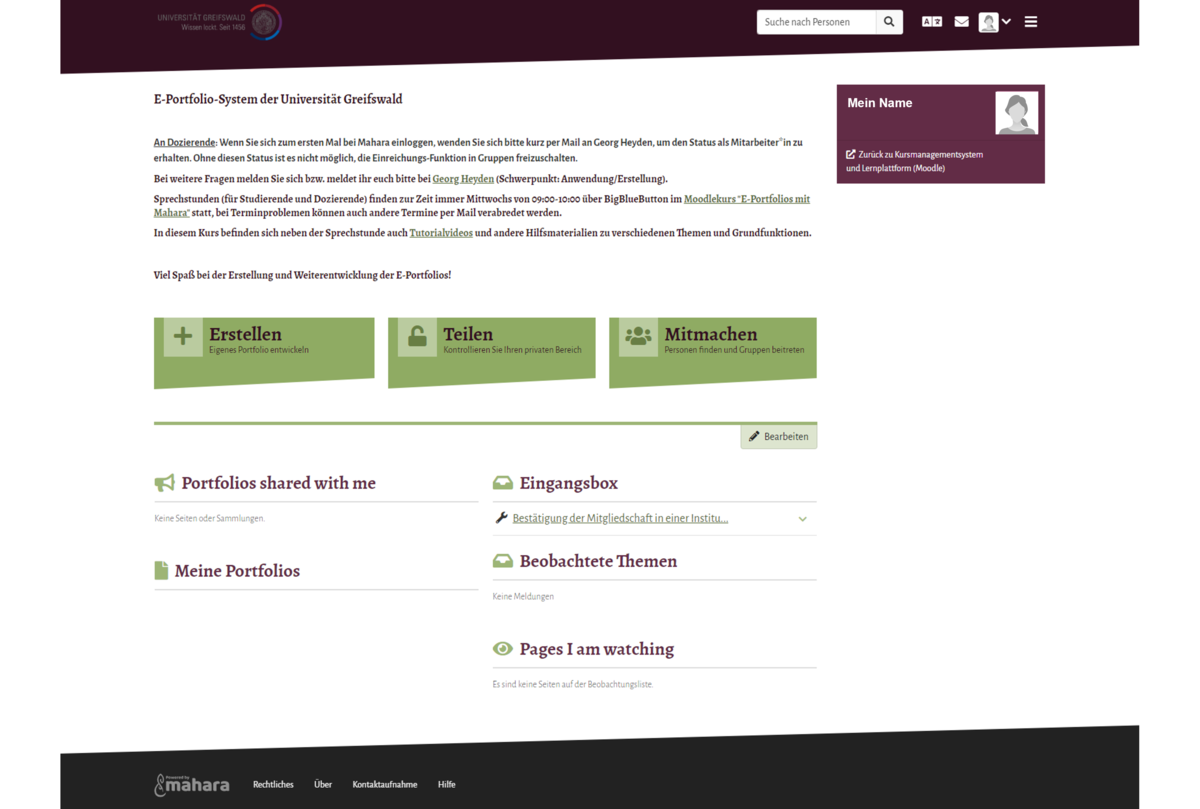Mahara
Creating E-Portfolios with Mahara
What is Mahara?
Mahara is the University of Greifswald’s digital portfolio system, which allows you to set up and share your own e-portfolios, blogs or individual and group presentations. Selected documents, media and entries can be compiled, managed, organised and displayed in different layouts as desired (e.g. as learning diaries, blogs or résumés).
What is an e-portfolio?
An e-portfolio is a kind of personal website where students can document, consider and reflect on their educational journey. The e-portfolio is therefore a reflection of the learning process. The materials posted in the personal e-portfolio display the qualifications and competences of the students.
Who can access Mahara?
Who can access Mahara?
While Moodle is designed for overarching teaching and learning scenarios, Mahara is a personal learning environment and focuses on self-reflective and social learning and is thus an ideal supplement to Moodle. Students and teachers can use Mahara and find out how to access the platform in the Mahara Moodle course [de].
In Mahara there are no courses and hierarchies, instead everyone has their own content and portfolio area that they can share with others. Every user can create content and upload files. A portfolio can be designed alone or together with others.
Comprehensive access control enables both cooperation with each other as well as the presentation, reflection and evaluation of individual learning processes.
Mahara can be accessed via Moodle [de].
What are the advantages of using Mahara?
What are the advantages of using Mahara?
Mahara offers a personal learning environment for self-reflection.
Mahara promotes networking, exchange and collaborative work in groups. As such, Mahara has similarities with a social network.
Mahara distinguishes itself through the simple and straightforward creation of e-portfolios.
Mahara can be used during studies as an accompanying learning tool and is particularly suitable for the practical phases in teacher-training degree courses, but Mahara is also quite suitable for other seminars, where it can be used to document the learning progress.
The group function makes it possible to share learning results - that way Mahara supports collaborative learning. In addition, there is the possibility of mutual feedback that can be used, for example, by students to comment on "views" and "collections" of their fellow students.
Mahara can be used by all students and lecturers at the University of Greifswald and, above all, it is free of charge.
What comes with Mahara?
What comes with Mahara?
the e-portfolio (with "views" and "collections")
the groups and their forums for interaction with one another
the profile with personal details
What can I do with Mahara?
What can I do with Mahara?
Mahara can be used in a variety of ways to document and reflect on the learning and development processes. In detail, for example,
blogs (learning diaries) can be managed,
files (documents, pictures, videos,...) can be collected and administered,
websites/portfolios (called "views" in Mahara) can be created and shared with others,
plans can be created, e.g. for documenting/planning processes and developments (writing a coursework essay),
groups can be formed and used for collaborative work and exchange (joint file management, discussion and arrangements in forums, creation of group views or collections...).
You can use Mahara as a reflection tool in seminars, during practical phases, or for creating a learning or application portfolio.
This is how: Video tutorials [de] on how to use Mahara can be found on GrypsTube.
The open source project Mahara was launched in 2006 by the New Zealand Ministry of Education together with several New Zealand universities. The word Mahara means "thought" or "thinking" in the TeReoMāori language.
You can reach Mahara through the University of Greifswald's Moodle at moodle.uni-greifswald.de [de] (Shibboleth authentication).
This is what Mahara looks like:
Tutorial content for getting started with Mahara
In the Mahara Moodle course [de] there are many new video tutorials aimed at both students and lecturers. In addition, the Mahara account "Mahara Tutorials and Examples", which can be found via the person search in Mahara under the search term "tutorials", provides some sample portfolios on the profile page.
For students there is a self-study course presented in the form of a number of videos explaining everything from the first login and the creation of content to the submission of the finished portfolio. The starting point for the self-learning content can be found under the tile titled: "Tutorials for Students: The Mahara self-study course" in the linked Mahara Moodle course.
For lecturers there is also new content centred around getting started with Mahara, creating and configuring groups, as well as handling submissions and providing feedback on them. The content can be found using the button "Tutorials for lecturers: Getting started with Mahara" in the Mahara Moodle course linked above.
The Mahara ePortfolio project team welcomes feedback via email or comment on the relevant Mahara pages. Furthermore, the digital Mahara consultation hour takes place every week in the Mahara Moodle course and can be used for any questions regarding Mahara.




